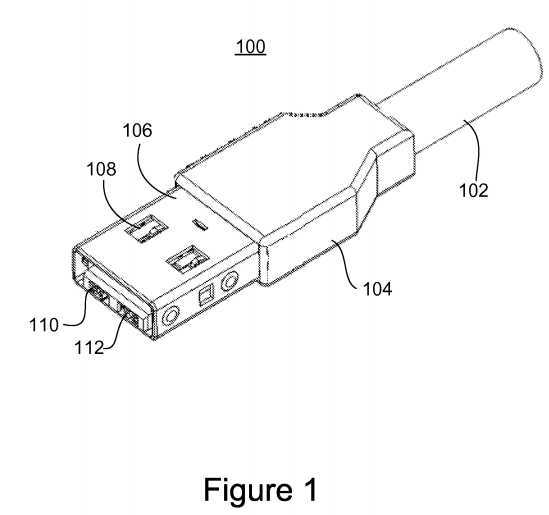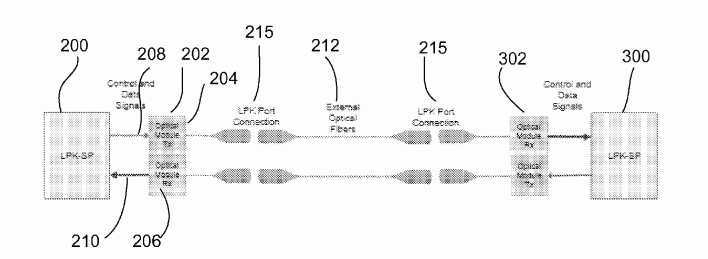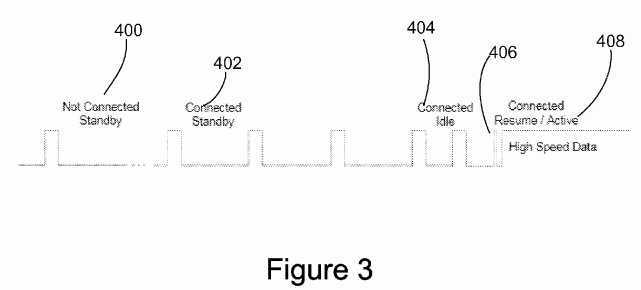标签:des style class blog http tar
Embodiments of the present invention are directed to optical links and, more particularly, to optical links which may save power when the optical link is unplugged and maintain eye safety standards.
Most optical links to date are used in the telecom and datacom industries, where optical modules tend to be connected during installation, and stay connected for the life of the equipment. These connections stay active as long as the link is connected, never switching off once started.
Optical links to be used in a consumer application may have different requirements, as the links are used dynamically, with devices being plugged and unplugged from the systems. In this case, it is desirable to save power when a port is not being used, insure that the port meets eye safety standards when the fiber is not connected, and that the port is able to robustly and reliably detect connections as they occur.
Meeting the simultaneous requirements of low power during idle times, eye safety, and robust connection detection requires the implementation of a power management scheme for the optical link.
Referring now to FIG. 1 there is shown an example of a universal serial bus (USB) device with additional optical capabilities for achieving even greater bandwidths. The USB device?100?has been referred to as the so-called Light Peak (LPK) optical USB. As shown, a cable?102?may join with a plastic housing?104. A plug head 106?may include openings?108?in the head?106?used to lock the connector in place when plugged into a corresponding female connector. Optical ports?110?and?112?may be housed in the head?106?to provide optical capabilities. Optical port?110?may for example be to connect to an optical transmitter (Tx) module and optical port?112?may connect to an optical receiver (Rx) module.

Referring to FIG. 2, there is shown a dual simplex optical link according to one embodiment of the present invention. In the Light Peak implementation, the components involved comprise a Light Peak Switch Port (LPK-SP)?200?and a Light Peak Optical Module (LPK-OM)?202. The LPK-OM?202?may comprise an optical transmit (Tx) module?204?and an optical receiver (Rx) module?206. Control and data signals?208?and?210?between the LPK-SP?200?and the LPK-OM?202?select the various power states of the module?202?and directly control the on/off conditions of the laser transmitter?204.

The optical receiver?206?may also be placed in the various power states, and then uses the received optical signals to indicate link states to the receiving portion of the LPK-SP?200. A complete optical link may comprise a LPK-SP?200?and LPK-OM?202?on one side, an optical fiber connection?212, and another LPK-OM?302and LPK-SP?300?on the other side. Each link is dual-simplex, with each side having a transmit channel connected to the opposite side receive channel. A separate fiber may be used for each direction, with both fibers?212?contained in the same optical cable.
Future implementations may combine the LPK-SP?200?and LPK-OM?202?into a more integrated unit, where the control and data Signals?208?become internal to the design. However, the power management functionality and states being used to control the optics would still exist.
Another option may be the integration of the LPK-OM?202?into a mechanical connector eliminating the fiber jumper from the LPK-OM?202?to the LPK Port Connection?215, and building the system side of the port connection directly into the mechanical connector. This scheme also would not alter the power management functionality between the LPK-SP?200?and the LPK-OM?202; it only changes the physical connection of the LPK-OM optical interface.
Future implementations may also include additional high speed signals, implemented as additional fibers and/or additional wavelengths of light sharing a single fiber or multiple fibers. Power management functionality would also be required for these implementations. In fact, the power management may become more critical in meeting eye safety criteria, as the additional optical signals may increase the optical power being carried by a connection.
When an optical port has no connection, it is desirable to save as much power as possible, and it is desired to meet eye safety standards. This is achieved by placing the optical module into a very low power Standby state, where the transmit laser?204?is disabled most of the time. The transmit stage?204?consumes almost no power while the laser is disabled. At the same time, the receive stage?206?has minimal functionality, where it only needs to detect the presence of low speed optical pulses (LSOP) and signal these pulses to the LPK-SP?200.
In order to actually detect a connection, the transmit stage?204?is pulsed on periodically, with a very low duty cycle, low speed pulse. The pulse represents below a 0.25% duty in one embodiment. This saves a significant amount of power for transmit stage?204?and easily meets the eye safety standards for an open port. When a physical connection is made, by connecting optical fiber between the two sides of the link, the link partner receiver?302?would detect the low speed optical pulse (LSOP), and signal the reception to the LPK-SP?300. At this point, the LPK-SP?200?can begin the detection process.
For robust connection detection, including the avoidance of false connection detection, the LPK-SP?200?may use a number of LSOPs to be received before deciding that a connection exists. For example, three pulses in a row, with no missing pulses, may be used to indicate that a fiber is connected. Once the pulses have been detected, the LPK-SP?200?commands the LPK-OM?202?to transition to a higher power Idle state, where more functionality is enabled and where higher speed responses are possible. The connection uses a modified LSOP, with a somewhat higher duty cycle of about 1% to signal to the link partner that the Idle state has been activated. The LPK-SP?200?and LPK-OM?202?continue this signaling until both sides of the link are in the same state. That is, the LPK-SP?200?is both sending and receiving the modified LSOP.
Once both sides of the link are signaling the modified LSOP, the link is transitioned to the Active state, using a different LSOP signal called RESUME. While in the Active state, the optical link is fully functional, sending high speed data from each transmit stage to the link partner receive stage. This involves higher power consumption, as all high speed data circuits are operational, and the optical signal is being modulated with the high speed data. Since the optical fibers are now connected in the link, the eye safety standards allow a higher power optical signal to be transmitted, as the signal will not be exposed to an open port while the fiber is connected.
The above described connection signaling scheme is illustrated in FIG. 3. When the optical link is not connected?400?the optical link is in a standby state and disabled most of the time as shown pulsing at a duty cycle below 0.25% using very little power and easily meeting eye safety standards. Once connected the link goes into a connected standby state?402?and the transmitter pulses a number of pulses, for example three low speed optical pulses, in a row signaling the receiver on the other side that a connection has been made. The optical link then transitions to a higher power Connected Idle state?404, for example a 1% duty cycle pulses, where more functionality is enabled and where higher speed responses are possible. This enables detection of a shorter duration RESUME pulse?406?to transition to an Active state?408?wherein the optical link is fully functional, sending high speed data from each transmit stage to the link partner receive stage.

Once in the Active state?408, the link can transition back and forth between Active and Idle without the fiber being disconnected. This represents another opportunity to save power in cases where there is a pause in the data flow. Since the fibers stay connected, it is possible to quickly transition back and forth between the Active and Idle states, as needed. During extended Idle states, the transmit stages send another LSOP signal, call CONNECT, to indicate that the fibers are still connected and that the link is still enabled. Note that the transition between Active and Idle can be independent in each fiber direction, so one link partner could be sending high speed data to the corresponding receive stage, while that transmit stage is signaling only the CONNECT pulses in the opposite direction.
If the fibers are disconnected from an enabled link, either on purpose, or due to a fault, the receive stage will no longer be receiving any optical signal, and the LPK-OM?202?will signal this case to the LPK-SP?200. If the receive stage was in the Idle state, receiving only the CONNECT LSOP signals, these signals will also no longer be detected. This would be the indication that the link has been disconnected. At this point, the LPK-SP?200?will disable the transmit stage, to again comply with the eye safety standards, then the LPK-OM?204?back to the Standby state, where it will wait for another connection.
In the case of multiple fiber or multiple wavelength connections, the connection detection can be performed on one fiber or wavelength at a time in order to keep the eye safety classification as low as possible. Other signals would stay disabled until a connection is established through the primary control signals. The disconnect from an enabled link, either on purpose, or due to a fault, is performed on each fiber and wavelength independently and the link is fully disabled to comply with the eye safety standards. The multi channel connection is then placed in the Standby state, where it waits for another connection by sending LSOP on one fiber or wavelength at a time.
The LPK-OM?204?should maintain the eye safety limits even when faults occur that would cause the optical signals to exceed these limits. Circuitry exists to shut down the laser in any fault situation; open, hardware short, or software issue, that would cause a violation to the eye safety limits.
This power management scheme takes the best advantage of a dynamic connection environment, where ports may be connected and disconnected at any time, and where data flows may start and stop as needed by the applications using the high speed data links. Power consumption is optimized, eye safety standards are met, and robust connection detection is preserved.
As a side benefit, running the transmit lasers in a higher power mode after the fibers are connected allows a larger range of laser transmit power to be used than has been the case in traditional telecom or datacom connections. This enables higher production yields for the lasers, larger link margins with similar eye safety classifications, and lower costs for the optical modules. This benefit would not be possible without the power management scheme to keep laser power very low while the fibers are disconnected.
SRC=http://www.freepatentsonline.com/8712236.html
PatentTips - Power management implementation in an optical link,布布扣,bubuko.com
PatentTips - Power management implementation in an optical link
标签:des style class blog http tar
原文地址:http://www.cnblogs.com/coryxie/p/3790016.html